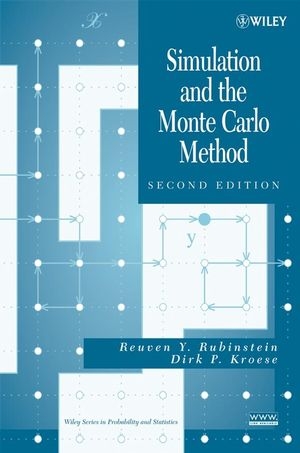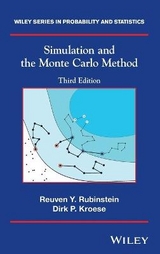
Simulation and the Monte Carlo Method
Wiley-Blackwell (Verlag)
978-0-470-17794-5 (ISBN)
- Titel erscheint in neuer Auflage
- Artikel merken
This accessible new edition explores the major topics in Monte Carlo simulation Simulation and the Monte Carlo Method , Second Edition reflects the latest developments in the field and presents a fully updated and comprehensive account of the major topics that have emerged in Monte Carlo simulation since the publication of the classic First Edition over twenty-five years ago. While maintaining its accessible and intuitive approach, this revised edition features a wealth of up-to-date information that facilitates a deeper understanding of problem solving across a wide array of subject areas, such as engineering, statistics, computer science, mathematics, and the physical and life sciences. The book begins with a modernized introduction that addresses the basic concepts of probability, Markov processes, and convex optimization.
Subsequent chapters discuss the dramatic changes that have occurred in the field of the Monte Carlo method, with coverage of many modern topics including: Markov Chain Monte Carlo Variance reduction techniques such as the transform likelihood ratio method and the screening method The score function method for sensitivity analysis The stochastic approximation method and the stochastic counter-part method for Monte Carlo optimization The cross-entropy method to rare events estimation and combinatorial optimization Application of Monte Carlo techniques for counting problems, with an emphasis on the parametric minimum cross-entropy method An extensive range of exercises is provided at the end of each chapter, with more difficult sections and exercises marked accordingly for advanced readers. A generous sampling of applied examples is positioned throughout the book, emphasizing various areas of application, and a detailed appendix presents an introduction to exponential families, a discussion of the computational complexity of stochastic programming problems, and sample MATLAB programs.
Requiring only a basic, introductory knowledge of probability and statistics, Simulation and the Monte Carlo Method , Second Edition is an excellent text for upper-undergraduate and beginning graduate courses in simulation and Monte Carlo techniques. The book also serves as a valuable reference for professionals who would like to achieve a more formal understanding of the Monte Carlo method.
Reuven Y. Rubinstein, DSc, is Professor Emeritus in the Faculty of Industrial Engineering and Management at Technion-Israel Institute of Technology. He has served as a consultant at numerous large-scale organizations, such as IBM, Motorola, and NEC. The author of over 100 articles and six books, Dr. Rubinstein is also the inventor of the popular score-function method in simulation analysis and generic cross-entropy methods for combinatorial optimization and counting. Dirk P. Kroese, PhD, is Senior Lecturer in Statistics in the Department of Mathematics at The University of Queensland, Australia. He has published over fifty articles in a wide range of areas in applied probability and statistics, including Monte Carlo methods, cross-entropy, randomized algorithms, tele-traffic theory, reliability, computational statistics, applied probability, and stochastic modeling.
Preface. Acknowledgments. 1. Preliminaries 1. 1.1 Random Experiments. 1.2 Conditional Probability and Independence. 1.3 Random Variables and Probability Distributions. 1.4 Some Important Distributions. 1.5 Expectation. 1.6 Joint Distributions. 1.7 Functions of Random Variables. 1.8 Transforms. 1.9 Jointly Normal Random Variables. 1.10 Limit Theorems. 1.11 Poisson Processes. 1.12 Markov Processes. 1.12.1 Markov Chains. 1.12.2 Markov Jump Processes. 1.13 Efficiency of Estimators. 1.14 Information. 1.15 Convex Optimization and Duality. 1.15.1 Lagrangian Method. 1.15.2 Duality. Problems. References. 2. Random Number, Random Variable and Stochastic Process Generation. 2.1 Introduction. 2.2 Random Number Generation. 2.3 Random Variable Generation. 2.3.1 Inverse-Transform Method. 2.3.2 Alias Method. 2.3.3 Composition Method. 2.3.4 Acceptance-Rejection Method. 2.4 Generating From Commonly Used Distributions. 2.4.1 Generating Continuous Random Variables. 2.4.2 Generating Discrete Random Variables. 2.5 Random Vector Generation. 2.5.1 Vector Acceptance-Rejection Method. 2.5.2 Generating Variables From a Multinormal Distribution. 2.5.3 Generating Uniform Random Vectors Over a Simplex. 2.5.4 Generating Random Vectors, Uniformly Distributed Over a Unit Hyper-Ball and Hyper-Sphere. 2.5.5 Generating Random Vectors, Uniformly Distributed Over a Hyper-Ellipsoid. 2.6 Generating Poisson Processes. 2.7 Generating Markov Chains and Markov Jump Processes. 2.8 Generating Random Permutations. Problems. References. 3. Simulation of Discrete Event Systems. 3.1 Simulation Models. 3.2 Simulation Clock and Event List for DEDS. 3.3 Discrete Event Simulation. 3.3.1 Tandem Queue. 3.3.2 Repairman Problem. Problems. References. 4. Statistical Analysis of Discrete Event Systems. 4.1 Introduction. 4.2 Static Simulation Models. 4.3 Dynamic Simulation Models. 4.3.1 Finite-Horizon Simulation. 4.3.2 Steady-State Simulation. 4.4 The Bootstrap Method. Problems. References. 5. Controlling the Variance. 5.1 Introduction. 5.2 Common and Antithetic Random Variables. 5.3 Control Variables. 5.4 Conditional Monte Carlo. 5.4.1 Variance Reduction for Reliability Models. 5.5 Stratified Sampling. 5.6 Importance Sampling. 5.6.1 The Variance Minimization Method. 5.6.2 The Cross-Entropy Method. 5.7 Sequential Importance Sampling. 5.7.1 Non-linear Filtering for Hidden Markov Models. 5.8 The Transform Likelihood Ratio Method. 5.9 Preventing the Degeneracy of Importance Sampling. 5.9.1 The Two-Stage Screening Algorithm. 5.9.2 Case Study. Problems. References. 6. Markov Chain Monte Carlo. 6.1 Introduction. 6.2 The Metropolis-Hastings Algorithm. 6.3 The Hit-and-Run Sampler. 6.4 The Gibbs Sampler. 6.5 Ising and Potts Models. 6.6 Bayesian Statistics. 6.7 Other Markov Samplers. 6.8 Simulated Annealing. 6.9 Perfect Sampling. Problems. References. 7. Sensitivity Analysis and Monte Carlo Optimization. 7.1 Introduction. 7.2 The Score Function Method for Sensitivity Analysis of DESS. 7.3 Simulation-Based Optimization of DESS. 7.3.1 Stochastic Approximation. 7.3.2 The Stochastic Counterpart Method. 7.4 Sensitivity Analysis of DEDS. Problems. References. 8. The Cross-Entropy Method. 8.1 Introduction. 8.2 Estimation of Rare Event Probabilities. 8.2.1 The Root-Finding Problem. 8.2.2 The Screening Method for Rare Events. 8.3 The CE-Method for Optimization. 8.4 The Max-cut Problem. 8.5 The Partition Problem. 8.6 The Travelling Salesman Problem. 8.6.1 Incomplete Graphs. 8.6.2 Node Placement. 8.6.3 Case Studies. 8.7 Continuous Optimization. 8.8 Noisy Optimization. Problems. References. 9. Counting via Monte Carlo. 9.1 Counting Problems. 9.2 Satisfiability Problem. 9.2.1 Random K-SAT (K-RSAT). 9.3 The Rare-Event Framework for Counting. 9.3.1 Rare-Events for the Satisfiability Problem. 9.4 Other Randomized Algorithms for Counting. 9.4.1 Complexity of Randomized Algorithms: FPRAS and FPAUS. 9.5 MinxEnt and Parametric MinxEnt. 9.5.1 The MinxEnt Method. 9.5.2 Rare-Event Probability Estimation Using PME. 9.6 PME for COPs and Decision Making. 9.7 Numerical Results. Problems. References. Appendix A. A.1 Cholesky Square Root Method. A.2 Exact Sampling from a Conditional Bernoulli Distribution. A.3 Exponential Families. A.4 Sensitivity Analysis. A.4.1 Convexity Results. A.4.2 Monotonicity Results. A.5 A simple implementation of the CE algorithm for optimizing the 'peaks' function. A.6 Discrete-time Kalman Filter. A.7 Bernoulli Disruption Problem. A.8 Complexity of Stochastic Programming Problems. Problems. References. Acronyms. List of Symbols. Index.
| Reihe/Serie | Wiley Series in Probability and Statistics |
|---|---|
| Verlagsort | Hoboken |
| Sprache | englisch |
| Maße | 165 x 238 mm |
| Gewicht | 620 g |
| Themenwelt | Informatik ► Grafik / Design ► Digitale Bildverarbeitung |
| Mathematik / Informatik ► Mathematik ► Analysis | |
| Mathematik / Informatik ► Mathematik ► Wahrscheinlichkeit / Kombinatorik | |
| ISBN-10 | 0-470-17794-2 / 0470177942 |
| ISBN-13 | 978-0-470-17794-5 / 9780470177945 |
| Zustand | Neuware |
| Haben Sie eine Frage zum Produkt? |
aus dem Bereich



